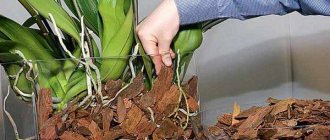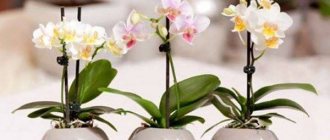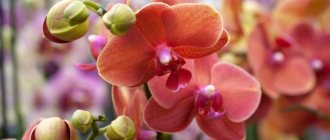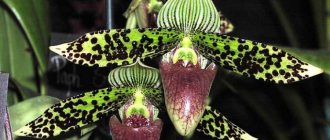Tropical beauties, differing exotic forms and developmental features, have a structure typical of flowering plants:
- They have leaves;
- Stems;
- Roots;
- Flowers.
And the presence of buds is mandatory - the rudiments of any of the plant’s ground organs.
Buds play an important role in the life of orchids:
- Generative ones are responsible for offspring;
- Vegetative ones serve for growth and development;
- But they can also participate in reproduction (adventitious and dormant buds can transform into children).
Below we will tell you everything about orchid buds - various questions and answers to them.
Features of orchid development
The division of orchids according to the type of growth into two groups determines their difference in structure and development features:
- Monopodial species (Phalaenopsis, Vanilla, Vanda, Ascocentrum) are distinguished by the presence of only one crown growth point, which implies the development of the plant straight upward with the constant laying of new leaves and aerial roots along the entire stem. Flower buds form exclusively in the leaf axils. Vegetative side - mostly sleeping, ready to wake up if necessary. These orchids do not have special formations (bulbs, rhizomes), storing nutrients in the leaves;
Monopodial type of orchid. - The sympodial type of branching (in Cattleya, Lelia, Cymbidium, Dendrobium, Odontoglossum) is characterized by the development of the plant in the horizontal plane due to the formation of rhizomes (ground or underground shoots). The buds on them give rise to vertical growth during the growing season, at the end of which the apical growth point dies or, having stopped developing, forms a pseudobulb. Next, new growth is formed due to the lateral development of the primordia at the base of the bulbs. Flower buds appear : Leaves grow from the bud;
- In internodes;
- Or at the base of the shoot.
Orchids are divided into monopodial and sympodial species.
Vegetative method of propagation
How does an orchid bud swell? In home culture, the most acceptable method for propagating tropical beauties is the vegetative (asexual) method , which involves using part of the mother plant. It could be:
- Cuttings;
- Division;
- Formation of lateral layers or children on the peduncle.
The young specimen obtained as a result of such reproduction is genetically completely consistent with the donor orchid .
IMPORTANT! For any method of vegetative propagation, you should choose a sufficiently large and healthy mother plant and ensure that the daughter parts have at least 3 dormant buds.
In sympodial species, the easiest way to propagate is by simply dividing the bush into parts (2-4 pseudobulbs each); for monopodial orchids, cuttings and growing babies are more often suitable.
What does a baby orchid from a bud look like?
Some types of orchids are characterized by the formation of babies from dormant buds at the base of the basal neck or on the peduncle. A baby is a new independent plant in miniature with its own leaves, roots, and sometimes peduncles, attached to the mother specimen.
Most often, a baby is formed on the peduncle of an orchid.
For the full development of a new orchid, the baby must be separated and planted in a separate pot . But this can be done only after it has several leaves (they form first in the baby) and the roots have grown to 4-5 cm. Such a “bush” at the age of six months is ready for replanting.
Orchid care
Contrary to popular belief, an orchid does not require any complicated care, but certain principles for maintaining this culture should be adhered to.
First of all, you need to monitor the air humidity - it should not be lower than 65%. In addition, you need to take into account the lighting; it should not be made direct. The best light is diffused. But there is no need to shade the place of growth, otherwise you risk not seeing the flowers at all.
Before she put out a flower stalk
In order for the plant to develop well and begin to bloom, a number of conditions must be created for the flower, in addition to certain humidity and temperature:
- in winter, when daylight hours are shortened, the crop needs lighting;
- try not to move the pot often, this is always stressful for the flower;
- use fertilizer containing phosphorus and calcium, but it is better to exclude nitrogen during flowering;
- abundant and frequent watering of the plant does not stimulate the appearance of a peduncle, but it can quickly cause rotting of the roots;
- It’s best to just make sure that the substrate is a little damp all the time;
- If necessary, you can use a special humidifier, but not an air conditioner.
IMPORTANT! To stimulate flowering, you can slightly lower the room temperature or move the plant to a cool place. You can reduce watering a little. Flower growers call this stimulation method the creation of artificial stress
Sometimes it helps. Too comfortable conditions pamper the orchid, it does not need to form seeds, it is already good
Florists call this method of stimulation the creation of artificial stress. Sometimes it helps. Too comfortable conditions pamper the orchid, it does not need to form seeds, it feels good as it is.
After his appearance
The very appearance of a peduncle does not guarantee the formation of buds. You should continue to care for the plant:
- Once again, make sure that your green pet is not exposed to direct sunlight; in the summer this can cause burns;
- in winter, to maintain humidity, you can place a flower pot in a container with water, at the bottom of which lay expanded clay to improve the evaporation process;
- Lack of light can cause buds to drop. In the autumn-winter period, be sure to use lighting;
- abundant watering is not needed, once a week is enough;
- Feeding during this period is absolutely necessary; it is advisable to apply a special liquid fertilizer intended for orchids twice a month.
After flowering, the peduncle usually dries out; it is recommended to trim it. If it remains green at the base, pruning should be done only to this point.
What is an orchid bud? The role of meristems in the life of “daughters of the air”
How to grow an orchid from a bud? From a botanical point of view, the buds of orchids, like other plants, are the rudiments of future terrestrial organs. Depending on the internal contents they are divided into :
- Vegetative (future stems and leaves);
- And generative (future inflorescences and single buds).
Each plant must have rudiments :
- Apical (located at the tip of the stem);
- Axillary (hiding at the base of the leaves);
- Accessory (formed on adult parts - shoots, leaves, roots);
- Dormant (frozen in their development until a certain time).
All types of buds have their own specific task :
- Growing up;
- Formation of branches;
- Reproduction;
- Or renewal.
ATTENTION! Dormant buds have a second name - meristem. Their location is in the axils of the leaves and on the flower arrow (lower scaly formations - up to 4 pieces). Each meristem, under different growing conditions of an orchid, is capable of forming a peduncle or child.
Bud - a way to propagate orchids at home
Under natural conditions, orchid buds are responsible mainly for increasing the above-ground part , that is, for the growth of the plant. In the process of reproduction, only generative primordia are involved, forming peduncles and participating in this way in the formation of seeds.
What does a peduncle bud on an orchid look like? In home culture, it is quite difficult to propagate exotic beauties with seeds, so the role of the buds changes dramatically. The orchid shot out from a dormant bud , no longer taking part in sexual reproduction. Under unfavorable conditions for flowering, they can produce babies - and this is their contribution to reproduction.
Babies can form from a bud on an orchid peduncle.
Vegetative buds begin to play the main role in the formation of new plants in home growing conditions . Adnexal buds are capable of producing lateral processes or children on:
- Mature leaves;
- Stems;
- Or roots;
- And also sleeping in the axils of leaves;
- At the basal neck;
- Or buds on flower stalks.
These formations, after a period of maturation on the mother plant, turn into new independent specimens .
The process of propagation by cuttings or division also involves vegetative lateral ocelli , which are forced to wake up to maintain the viability of the orchid. They form new ones:
- Shoots;
- Leaves;
- Kidneys;
- And then the flower stalks.
Meristem - what it looks like
A dormant bud or meristem is a rudiment that has begun to develop and, for some reason, has slowed down this process and fallen asleep .
It looks like a small scaly tubercle at the base of the basal neck or large thickenings on the lower part of the peduncle, covered for protection with dense visors of scales. The meristem can awaken:
- If necessary;
- Or when stimulated.
For an orchid, it plays the role of a guarantor in case of unfavorable conditions .
Interesting! Meristems have an essential reproductive function in the life cycle of orchids. Depending on the specific conditions of caring for the plant, they may form a baby or a peduncle.
It is necessary to cut off the peduncle of an orchid above the dormant bud.
In any of these options, the sleeping eye is involved in reproduction :
- In the vegetative stage - during the formation of a child;
- In sexual - when releasing a flower arrow (in the case of further artificial pollination and obtaining seeds).
Where can meristems form?
In sympodial species of orchids, dormant primordia are located at the base of old pseudobulbs or on peduncles - from them both new rhizomes (rhisomes) and children or peduncles can develop.
In orchids with a monopodial structure, almost all buds are considered meristems . They can be found:
- On the lower part of the peduncle (3-4 pieces closest to the base);
- On the run;
- Or at the base of the basal neck.
The meristem most often forms at the base of the orchid neck.
All of them, in a certain unfavorable situation or under the influence of stimulation, are transformed into a peduncle or baby.
Shoots from a bud - what is it: a peduncle or a baby?
The first time after the new arrow pecks, it is impossible to say with certainty what will grow as a result - a peduncle or a baby. At the very beginning of formation they are quite identical . But after 4 weeks, doubts will disappear by themselves, since the baby’s leaves will begin to develop during this period. If the arrow continues to grow, this is definitely a future peduncle.
But if it is impossible to immediately determine what will grow from the rudiment, then you can try to create favorable conditions for the formation of the organ that is needed. Adjusting the temperature, watering and lighting will help to grow another peduncle or child for reproduction.
How the peduncle appears - where and how it grows
The arrow of the Orchid is formed in the axil of the leaf. At first it appears between the leaf and the stem in the form of a small tubercle, then it thickens and becomes pointed at the top. The beginnings of buds are clearly visible on the shoot. In some varieties, the rudimentary scales may differ in color. The scales and tubercles are darker or contrast with the apex.
After 7-10 days, flower shoots of many varieties become articulated. They can also grow to the side or even curl up. After 3-4 weeks, individual branches will be clearly visible on them, which, in turn, bear racemose inflorescences. The total period of growth of the peduncle until the opening of the buds takes from 2.5 to 3.5 months for different varieties. If flower stalks began to form in October, then the period of mass flowering will occur in January - February.
Awakening period in natural conditions
How to awaken sleeping orchid buds? Under natural conditions, the life cycle of orchids depends on changes in the tropical climate .
The beginning of the awakening of life in the tropics coincides with the rainy season, when rising temperatures and very high humidity create favorable conditions for the rapid growth and development of all representatives of the flora.
At this moment, the “daughters of air” activate the increase :
- Green mass and root system;
- Meristems also hatch, capable of forming flower shoots or new shoots and children.
The sleeping bud of phalaenopsis awakens in the same way as in the others.
Care before and after flowering
There are certain requirements for caring for an orchid. It is necessary to strictly follow them, especially if the gardener wants to see his beauty bloom.
Experienced gardeners distinguish 5 life cycles of orchids: vegetation (growth of roots and leaves), dormancy (the period of release of the peduncle), flowering, rest, active vegetation (growth of new roots and leaves).
Temperature. The dormant period of a flower most often occurs in autumn (read about what to do with the arrow when the orchid has already bloomed). In order for an orchid to produce a flower stalk, it needs to be provided with maximum comfortable conditions. As a rule, in order for the plant to enter the dormant phase without stress, it is recommended to reduce the temperature level: from +25C to +15C. The main task is to ensure a noticeable difference between the thermometer readings during the day and at night. When the peduncle has already been released, the temperature rises slightly again.
Watering. During the growing season, the plant is systematically moistened as needed. You can understand whether moisturizing is needed visually (the color of dry and moistened roots is taken into account) or tactilely (the moisture level of the top layer of the substrate). Before releasing the peduncle, the epiphyte is subjected to an artificial drought: another 4–5 days, possibly more, are added to the expected time of watering. This measure is explained by the fact that in its natural habitat - the tropics - the orchid blooms its flowers during the period of “drought”, since daily tropical downpours do not allow insects to fly from flower to flower, thereby pollinating them. An artificial drought in a flower pot will give the orchid a “signal”: it’s time to bloom! When the peduncle has already been released, the epiphyte must not be forgotten to be watered, but this must be done again as the soil dries out. We remember the main rule: it is better to underfill an orchid than to overfill it. The recommended interval between waterings is from 7 to 12 days, depending on the living conditions of the beauty.
Feeding. If the orchid was fed before the release of the peduncle, then you should not stop doing this even after the shoot has been driven out until the first flower appears
Fertilizing is important before, not during, flowering. As a top dressing, it is advisable to use ready-made complex fertilizers for orchids containing nitrogen, phosphorus, and potassium. They are sold in specialized stores. If there was no fertilizing, then you should not start fertilizing the flower while the frog is being driven out - the consequences can be very disastrous.
If there was no fertilizing, then you should not start fertilizing the flower while the frog is grazing - the consequences can be very disastrous.
Light. Often, in order for the orchid to enter the resting phase, it is moved to a dark place
After the peduncle appears, the orchid needs to be provided with a lot of diffused light for its normal formation (southern, southeast, southwest windows). It is important that the daylight hours for the flower are at least 12 hours. If the growth of the arrow occurred in autumn (which happens most often), then it is necessary to provide the plant with additional lighting
Phytolamps are usually used for these purposes. The orchid does not like drafts and air currents. The pot with the plant must be placed away from the air conditioner, fan, or radiator. Under no circumstances should an orchid with a growing peduncle be replanted to avoid a stressful situation for the plant!
Read more about what to do with an orchid after it has released a peduncle in a separate article.
Awakening the buds of orchids at home
For the comfortable well-being of exotic beauties in home culture and to undergo all the processes of their life cycle planned by nature, flower growers need to study all the nuances of orchid growth in the natural environment and try to create a microclimate as close as possible to their natural habitat.
How does a bud appear on an orchid?
Monopodial species of orchids have one apical growth point , due to which the plant increases in height. Every year, during vegetative growth, new pairs of leaves are formed, in the axils of which meristems are laid. They may eventually develop into a peduncle or shoot. At the same time, lateral vegetative buds are formed on the trunk, producing young children in the future if necessary.
A bud forms on an orchid during vegetative growth.
In sympodial species, bud formation also occurs annually during the active phase of plant growth. Generative rudiments are formed:
- At the base of the shoot;
- At internodes;
- Or in the axils of leaves.
Vegetative ones are located on the lateral surfaces of rhizomes and give rise to new shoots and then pseudobulbs.
Important! Thus, the appearance of new eyes on orchids occurs constantly in regular cycles.
During what period is the greatest likelihood of a kidney appearing?
Under natural conditions, all life processes, including the formation of generative and vegetative rudiments, begin with the onset of favorable conditions for tropical beauties. According to the same laws, the life cycles of orchids in home culture occur.
In the spring, after a winter period of dormancy (in species with a full development cycle) or a short rest from flowering (in species without winter dormancy), when comfortable temperature and light conditions occur, orchids begin active growth and development , including laying new rudiments of future peduncles or processes.
Stimulating the awakening of the kidney at home
The kidneys have frozen and are not growing, how can I stimulate them? At home, the meristem can spontaneously wake up and form a peduncle or a new shoot - a baby. But if the conditions of care meet the requirements of the orchid and it feels great, then you may not wait for the awakening of the meristems for several years.
In this case, if you want to get a new arrow or start propagating your favorite flower with the help of children, you should stimulate the kidney . Depending on the desired result, the conditions for stimulation vary greatly. What do dormant buds look like? You can see this in the photo below.
When favorable conditions are created, the orchid's bud will open on its own.
To stimulate awakening in order to obtain offspring, it is necessary to create suitable conditions :
- Reduce the illumination of the plant by moving it to a shaded place;
- Maintain air humidity within 60%;
- Ensuring a difference between day and night temperatures within 10 degrees, but not lowering the daytime temperature below 25 degrees is an indispensable condition for awakening the vegetative, rather than floral, meristem;
- Reduce watering to a minimum, while fertilizing with nitrogen fertilizers (nitrogen increases the growth of greenery and makes flowering more difficult);
- Spray the orchid at least 5 times a day.
ADVICE! To awaken the meristem in order to produce babies, you should increase watering with mineral fertilizers every once in a while.
When optimal conditions are created, the plant can respond to the efforts of the grower and form a long-awaited baby from the awakened meristem.
To stimulate in order to obtain a peduncle, slightly different conditions are created :
- The temperature difference during the day should be maintained at about 6 degrees, but during the day the thermometer readings should not exceed 25 degrees - otherwise conditions will be created for the development of the baby;
- Reduce watering as much as possible until almost complete drought;
- An indispensable condition is to rest the plant for several months after the previous flowering;
- If the stimulation process falls in the autumn months, it is necessary to organize artificial lighting.
These conditions can help the orchid form another new peduncle , but if the previous flower arrow was completely removed, then the waiting time for flowering may be prolonged.
Optimal wake-up conditions
How to awaken sleeping kidneys? Is it possible to water an orchid when a bud appears? can be considered sufficient conditions for the awakening of the vegetative meristem :
- Weak watering;
- Sufficient shading;
- High temperatures (at least 25 degrees) combined with daily fluctuations;
- And increased doses of nitrogen fertilizers.
mode for awakening the generative bud :
- With increased lighting;
- Temperature no more than 25 degrees and daily fluctuations;
- As well as reducing watering for a stress push.
In any case, the orchid to be stimulated must be :
- Rested after flowering;
- Adult (over 3 years old);
- Healthy;
- With a strong root system;
- And at least 4 leaves.
Stimulation drugs
How to propagate an orchid, what to smear the bud with? If experiments to stimulate the awakening of meristems fail, flower growers use special preparations that increase the possibility of the appearance of peduncles or shoots. The best in this regard is considered to be hormonal cytokinin paste with essential vitamins. The main consequence of using the paste is the acceleration of cell division.
Cytokinin paste for awakening helps:
- Awaken the meristems;
- Form generative buds;
- Speed up the process of preparing for flowering;
- Form shoots in the required place.
To stimulate the buds of an orchid, cytokinin paste is often used.
Using the paste can create a small miracle - forming a new bud where there should not be one.
Application of cytokinin paste
Few people know the name of the ointment for stimulating the kidneys. The process of working with hormonal paste is not difficult . First you need to choose a suitable kidney. Next, use a sharp knife to remove the protective scales, having first carefully cut them on the sides.
under the scales is a small green formation , onto which, using a thin stick or toothpick, you need to apply the required amount of paste and easily distribute it over the entire area. Results can be expected in a week or 10 days.
CAREFULLY! Do not use cytokinin paste on young or small specimens, on apical shoots with leaves and roots - the orchid may suffer or die.
When using paste, you should adjust the volume applied to the object:
- To obtain a peduncle, a very small dose is needed;
- A large amount of paste will lead to the formation of a baby.
Many gardeners use cytokinin ointment to awaken the buds.
Increasing air humidity
However, reducing the amount of watering does not mean that the humidity level should also decrease. The air humidity around the orchid should always remain at the highest possible level (not lower than 95%). This is achieved by spraying the plants and humidifying the air in the room with flowers. Temperatures should remain within 22 – 27 degrees.
Such conditions are as close as possible to the natural conditions for an orchid in nature. So the awakening of the kidneys will not take long.
The appearance of a bud on an orchid peduncle
Buds appeared on the stick: what to do and how to care for it? The lower buds on the peduncle (usually 4 pieces, closest to the base of the arrow) are meristems , from which it is possible to peck a peduncle or vegetative shoot for reproduction. You can see a photo of a bud on a peduncle below.
The bud that appears on the peduncle is called a meristem.
The upper ones are responsible for the formation of inflorescences. When a bud appears on a peduncle, it is not immediately clear what it is.
New peduncle or baby?
The first month after the awakening of the meristem does not answer the question : what will grow as a result - a baby for reproduction or a peduncle with beautiful flowers? Both rudiments are very similar to each other. But as the new formation grows, it becomes clear which way the scales are tipped.
After about 4 weeks, the first leaves begin to form . If the shoot continues to increase in length without giving any branches, it means that a future peduncle is developing from the bud.
How long does an orchid's peduncle grow before it blooms?
The development period of each peduncle depends on many factors . The determining factor is the type of orchid - the ripening time of the peduncle varies among different species. For Phalaenopsis, this time takes approximately 2 months.
The duration of this period is significantly influenced by the conditions for caring for the plant . Optimal indicators reduce the time of formation of the peduncle until flowering. The main thing is to have good lighting: the more light, the shorter this period.
How to properly trim a peduncle to a dormant bud
behaves differently in each specimen . If the peduncle turns yellow and dries out, it should be removed after complete drying. If the arrow has dried only halfway, this means that the plant needs rest, it does not have enough strength to bloom again - the peduncle must be cut off completely. But if the arrow remains green after the end of flowering, then this is a sign of the possible formation of further flower stalks or children in the near future.
In the latter case, the arrow can be left alone , but partial trimming can be done. For the procedure, a disinfected pruner is used, which is less harmful to the plant than other tools. The peduncle is trimmed, leaving a third of the length for future flowering. The cut is made above the dormant bud, maintaining about 2.5 cm of shoot before it - otherwise there is a possibility of the meristem drying out.
How to grow a baby from a peduncle
How does a baby orchid bud appear? If it is necessary to trim the green peduncle (if the weakened orchid is given rest), it can be used to form children by cuttings . To do this, the cut arrow is divided into parts (about 4 cm) so that there is a healthy bud in the center of the cutting. The ends are disinfected with activated carbon.
The baby is grown on a peduncle using cuttings.
The finished cuttings are placed in containers with water in the light or placed in a greenhouse on damp moss . The babies are expected to arrive in about a month.
The children formed on the cuttings should produce leaves and several roots up to 4 cm in length. After this they are ready for transplantation:
- The remains of the mother shoot are cut off on both sides, leaving small stumps;
- And they put the baby in a suitable (not too large) pot.
If the baby is formed on a growing peduncle, the transplantation steps are identical to planting babies from cuttings. After transplanting, the pots with the babies are placed in a shaded, warm place for several weeks for the acclimatization period.
Instead of watering, spraying is used. Then care for new specimens according to the standard rules for this species.
But if a baby is formed on a shoot (basal), it cannot be replanted . Such a baby does not form its own roots and feeds on the mother plant. Separating and planting will certainly kill such a baby. It is advisable to leave it on the shoot - eventually the mother plant will die off, leaving a new specimen.
Orchid bud transplant and aftercare
The disadvantage of vegetative division is the small number of specimens obtained. To grow new orchids on an industrial scale, a method of meristem propagation or isolated bud culture was invented. In this option, individual buds or tissue particles are used: they are deposited on a nutrient medium in sterile boxes. After the children are formed, the method of transplanting and caring for young orchids is standard.
For use in amateur floriculture, this method is complex and time-consuming, but experiments are already being carried out . To achieve good results, the buds should be chosen correctly: the best ones are located closer to the base.
All about phalaenopsis flowering
The formation of buds requires a lot of strength and energy from any plant, and this species is no exception.
As a rule, a flowering specimen comes into the house, which was grown in special conditions with optimal humidity, temperature and a large amount of fertilizer.
After flowering, it will need time to adapt to new conditions, so you should not wait for the rapid formation of a new peduncle.
During flowering, the growth of leaves and roots stops and resumes only after the flowers fall and a short period of dormancy.
The plant begins to actively increase its vegetative mass and only after the formation of the required number of new roots and leaves is it ready to delight the owner again.
To survive flowering, the rosette must consist of 5-8 healthy leaves.
Advice! If the flower arrow has not completely dried out, then it is not worth cutting it to the ground, because new buds may form earlier on the side branches, but their number in this case will be much smaller.
Conditions of detention
When the bud of a peduncle appears, it is recommended to adjust the conditions of maintenance and care:
- Do not move the plant or rotate the pot around its axis unless absolutely necessary;
- If the plant decides to bloom in the autumn-winter period at a low level of illumination, then it is advisable to increase the daylight hours to 10-12 hours, organizing supplementary lighting with phytolamps or ordinary fluorescent lamps;
- Drafts and exposure to low temperatures must be avoided.
Photo of a blooming phalaenopsis under a phytolamp.
Feeding and watering
During the growth of the peduncle, special attention must be paid to watering, because a lack or excess of moisture can lead to premature fall of the buds. The plant requires more moisture, but still the substrate must have time to dry between waterings
If we talk about how to water a blooming orchid, then it should be taken into account that during this period the interval between waterings should be slightly shortened.
When choosing fertilizers, it is necessary to give preference to fertilizers with a predominance of potassium and phosphorus and a low nitrogen content. They will not only stimulate the signal for the formation of buds, but will also increase the lifespan of butterfly flowers.
Formation of a beautiful peduncle
Most store-bought phalaenopsis have erect, beautiful peduncles with a cascading cascade of flowers.
To get a similar appearance, you need to tie the new peduncle to a vertical support as it grows.
During the enlargement of buds and blossoming of flowers, phalaenopsis should be provided with one-way lighting, then all flowers will be turned in one direction. Only after complete dissolution can the plant be expanded.
Care after flowering
After flowering, it is necessary to provide a period of rest: from several weeks to several months. To do this, you need to eliminate fertilizing and reduce watering. You can also lower the temperature by a few degrees.
Stimulation
Sometimes a healthy plant with enough leaves refuses to bloom. Often the reason lies in too good and regular care. In this case, it is worth creating a stressful situation for the plant.
You can place the flower in the dark for several days or allow it to dry the substrate for a longer time. You can also stimulate the formation of flower stalks using special fertilizers for flowering and budding.
Flowering can be stimulated using special preparations.
You will learn more about the reasons for the lack of flowering and their elimination from this article.
Trimming
Phalaenopsis does not need pruning, but after flowering it is necessary to remove the dried peduncle. If the peduncle has dried only partially, then only cut off the dry part to the first living bud. The buds on the peduncle can produce new branches with buds.
Periodicity
The number of blooms depends on several factors:
- plant age;
- varietal characteristics;
- care;
- flowering duration.
In most cases, plants bloom 1-2 times a year, but some specimens can form one peduncle after another, being in bloom for almost the whole year.
Phalaenopsis blooms (photo on the windowsill).
Duration
The duration of orchid flowering at home depends on the plant variety and conditions. On average, flowers can last 2-3 months, but hybrids are known that can remain decorative for 6-9 months, and if there are several flower stalks, it seems that the plant blooms all year round.
Read more about the flowering times of phalaenopsis here.
Buds on the roots
Some orchids have the ability to reproduce by basal children , forming buds on the roots.
Sometimes a bud can grow on the root of an orchid.
This phenomenon occurs when the apical point of growth is damaged and serves as protection for the plant. In addition, basal children are formed in plants that have produced a peduncle from the growing point.
Is it possible to transplant such a kidney?
The children formed from the root buds are tightly connected to the mother plant . If the pot is large enough for two plants and both plants are doing well, then it is advisable to leave the baby in place.
If absolutely necessary, the baby can be carefully separated from the mother plant , but only if the root system of the young orchid has sufficiently grown. When replanting, you should be extremely careful with the roots of both the adult plant and the baby.
How to separate a root bud without ruining the plant
To separate the root children, the greatest care is required with the root system. First of all, determine whether the roots of the baby have grown by removing the top substrate from the pot. Then the roots are cleared of soil. Branch location first:
- Marked with a knife 1 cm from the baby;
- The root is cut;
- The young plant is freed.
After the procedure, both plants are treated with activated carbon and slightly dried before planting. All instruments must also be disinfected.
The most favorable time for transplantation
A favorable time for transplantation is considered to be the beginning of spring , when active vegetative growth has not begun, the plant has rested after winter and is full of strength. But if the child requiring transplantation does not have sufficiently developed roots, then the operation should be postponed until a later time.
Are there buds on aerial roots? What to do with them?
The aerial roots of an orchid are the same root system, the only difference is in the thickness of the protective layer of velamen. Very rarely, aerial roots can produce a basal child from a bud at the base in the same way as the main roots. The principle of working with such children is identical to working with rudiments on other parts of the plant. It’s not often that you see a bud appear on an aerial root, which then sprouts leaves.
What is a flower shoot?
The peduncle is a flexible and long stem on which buds bloom after reaching a certain length. Many flower growers use the concept of “peduncle” in a narrow sense - the section of the stem part of the plant on which the flowers are located.
The flower stalks grow very strangely: they bend in all directions, then begin to rise straight. They curl into rings; curled up like a pig's tail. It must be remembered that the flowering bud begins to emerge from the growing point.
The orchid's bud woke up on its own - what to do?
If the apical (outmost on the peduncle) bud of a flowering orchid unexpectedly awakens, then flowering will continue and several smaller flowers will additionally appear. You should not touch the peduncle unless there is a danger of weakening the plant.
If a bud appears suddenly, it is not recommended to touch it unless it harms the orchid.
The bud under the flower closest to the base of the arrow (lateral) may wake up on its own - cut off the inflorescence , retreating 3 cm from the hatched bud, from which a new peduncle or baby will then grow. But you can let the orchid bloom and only then cut off the remains of the inflorescence.
How does a flower send out arrows?
Usually, the plant develops its root system first, then enters a state of relative dormancy. During this period, you should not worry that the orchid seems to have frozen for a while: it is preparing to form an arrow. The process then goes like this:
- the peduncle sprout usually appears between the leaves, in the so-called axil;
- as a rule, an arrow forms between the lower leaves;
- in most orchids the peduncle grows towards the light, upward, but there are varieties in which the arrows hang down;
- scales form on the arrow itself, buds are born in them, from which flowers or branches of the peduncle will grow.
IMPORTANT! There is an opinion that a home orchid blooms once a year, in the fall, but this is not entirely true. With good care, some species of flower can form buds all year round. In adult orchids, the peduncle can grow up to a meter; the sight when the flowers bloom is very beautiful
As a rule, 1 peduncle appears on one plant. Experienced gardeners sometimes have 2 of them at once. A rare case is the simultaneous appearance of three. But such a profusely flowering plant weakens the plant greatly and for a long time, so some gardeners even specially cut off the third arrow
In adult orchids, the peduncle can grow up to a meter; the sight when the flowers bloom is very beautiful. As a rule, 1 peduncle appears on one plant. Experienced gardeners sometimes have 2 of them at once. A rare case is the simultaneous appearance of three. But such abundant flowering weakens the plant greatly and for a long time, so some gardeners even specially cut off the third arrow.
Is it possible to replant a plant with buds? Nuances
How is a kidney transplant performed, how to care for an orchid? For any plant that is preparing to flower, replanting is contraindicated. But there are emergency situations (the plant is sick, the roots have begun to rot, the flower has grown greatly) when the orchid needs help and it is impossible to wait for the end of flowering. Then the transplant is carried out, observing the nuances :
- When the roots rot, the peduncle is cut off; in other cases, it is advisable to shorten it a little;
- The roots are cleaned of the substrate, damage is trimmed, disinfected and dried;
- The remaining procedures are carried out according to the standard plan with extreme caution;
- After transplantation, place in a warm place with good lighting and do not water for several days.
If not properly cared for, the orchid's buds dry out.
Why do the buds turn yellow, dry out and fall off?
With proper care, the orchid forms buds and blooms for several weeks. All problems with the kidneys (except for age-related changes - after 5 years, orchids bloom reluctantly) occur due to violations of the care regimen . Bud fall is possible when:
- Excessive watering;
- Violation of temperature readings in any direction;
- Lack of lighting;
- Or from drafts.
To save the situation, all conditions for keeping the tropical beauty should be normalized.
Orchids, for the most part, very easily adapt to specific living conditions , and respond to care with active growth and abundant flowering. Knowledge about the developmental features of an exotic plant and the role of buds in its life cycle can help flower growers create more comfortable conditions for the “daughters of the air.” All you have to do is stick to routines and schedules and love your tropical guest.











